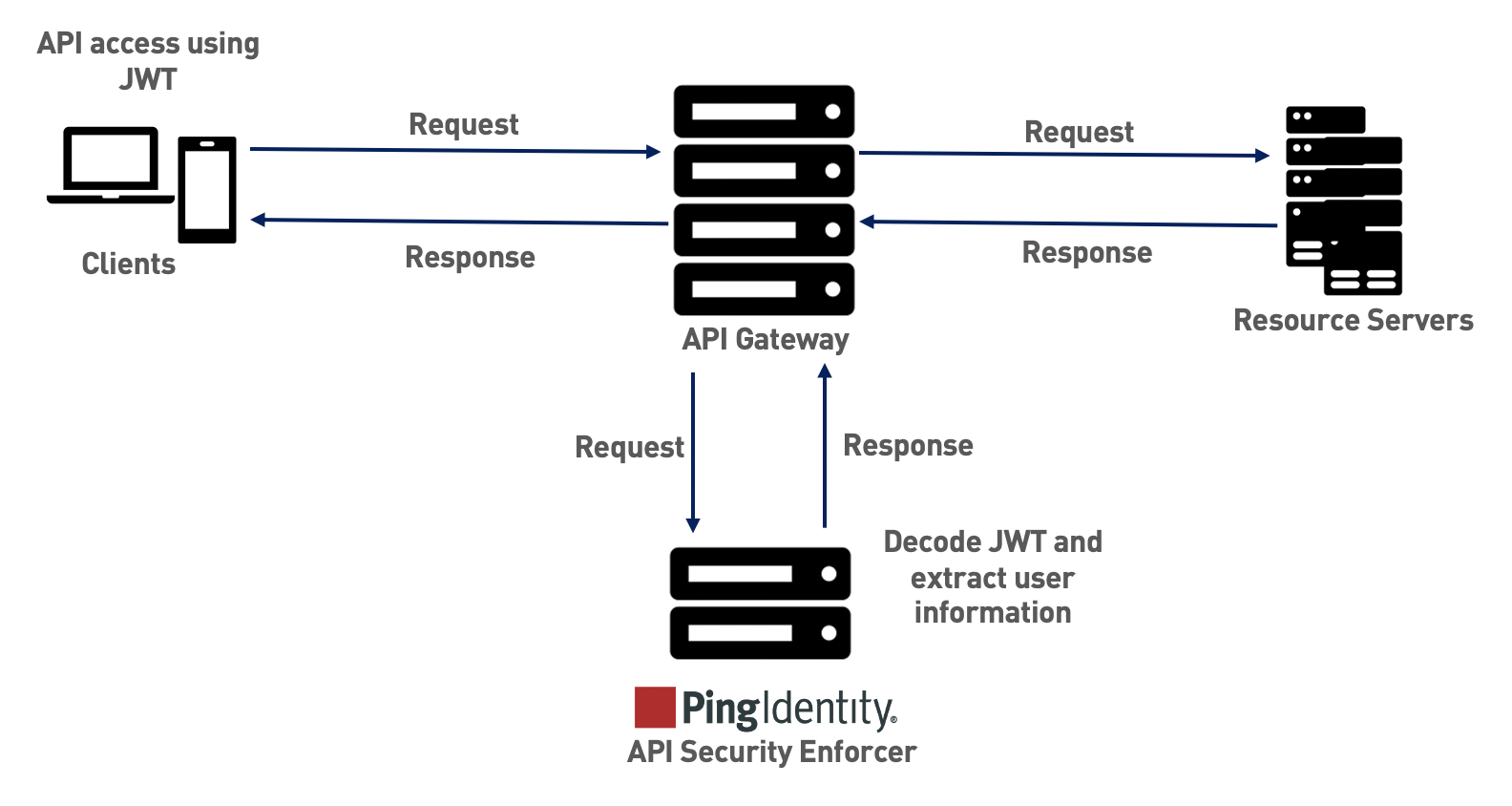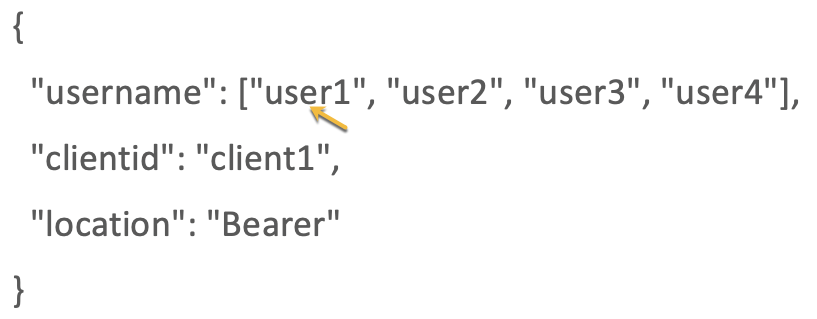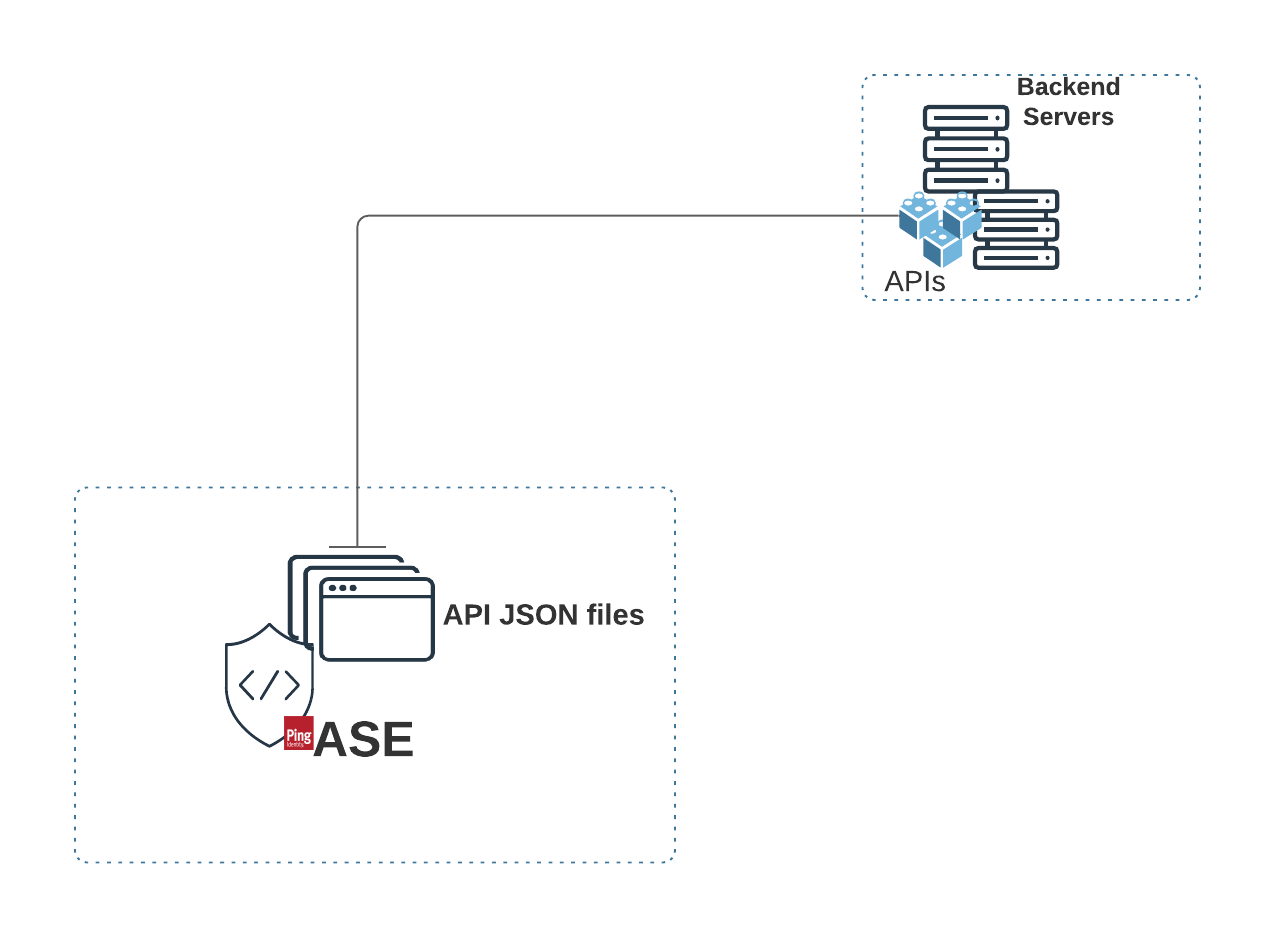Extract user information from JWT in sideband mode
The API Security Engine (ASE) supports the decoding of transparent JSON Web Token (JWT) received as part of application programming interface (API) requests. ASE extracts the user information from the JWT and logs it in ASE access logs. The API Behavioral Security (ABS) AI Engine analyzes these access logs to generate reports and detect attacks.
The following diagram shows the traffic flow when ASE is in sideband mode.

A JWT consists of a header, a payload, and a signature. They are concatenated with periods(.). The following is a sample JWT structure.

ASE decodes the payload to extract user information from a JWT. It can decode JWTs received as part of request headers or query strings. In sideband mode, ASE supports only Bearer scheme in the Authorization header.
|
ASE does not validate JWTs. It just decodes the JWTs and extracts the user information. |
ASE supports a list of usernames in JWT. When the username claim in the payload is an array with multiple elements, ASE extracts the first element of the array. The elements in the array can be strings or numbers and the array should be a valid JavaScript Object Notation (JSON) array.

|
ASE supports arrays only for username claims in the payload. It does not support arrays in clientid or location claims. |
When deployed in sideband mode, ASE receives the API request information from the gateway policy and extracts the metadata. The user_info object contains the user information along with other metadata. The following is an example snippet of information received by ASE from API gateway:
{
"source_ip": "127.0.0.1",
"source_port": 12345,
"method": "GET",
"url": "/api3?query=eyJ0eXAiOiJKV1QiLCJhbGciHuDXOyfQqAnoXC4bA&abc=xyz",
"http_version": "1.1",
"user_info":[{"username":"abc","client_id":"cabfsghhbsag"}],
"headers": [ { "host": "shop.com" },
{ "content-type": "application/xml" },
{ "content-length": "100" },
{ "x-forwarded-for": "dev.pxy.com" },
{ "user-agent": "Mozilla/5.0 (X11; Linux x86_64) AppleWebKit/537.36 (KHTML, like Gecko) Chrome/57.0.2987.110 Safari/537.36"
}
]
}ASE extracts the user information from the user_info object, JWT or both. The following scenarios explain the different ways in which ASE extracts user information:
-
If the gateway policy sends the user_info object with
usernameandclientid, ASE does not decode the JWT. It extracts the user information from the user_info object. -
If the gateway policy sends the user_info object without
usernameandclientid, ASE decodes the JWT to extract the information. -
If the gateway policy sends the user_info object without a
username, but withclientid, ASE decodes the JWT and extractsusernamefrom the JWT and client identifier from the user_info object. -
If the gateway policy sends the user_info object with a
username, but without aclientid, ASE decodes the JWT to extractclientidand captures theusernamefrom the user_info object. -
If the gateway policy does not send user_info object or sends an invalid user_info object, ASE decodes the JWT to extract the
usernameandclientidinformation if available.
|
If the JWT decoding fails, the API request is not blocked. ASE logs the information got from the gateway policy in the access logs. |
Configure API JSON files
This topic discusses what API JSON files are, and how they are configured to secure the APIs in your environment.
API JSON files are used to configure the behavior and properties of your APIs in ASE. The parameters in API JSON files help ASE to uniquely identify the APIs in your environment. Each API has a unique API JSON file in ASE. ASE ships with sample JSON files located in the /config/api directory.
The parameters configured in an API JSON file help ASE extract metadata from API traffic, set decoys to trap intruding attacks, perform health checks on backend servers, and so on. The API JSON parameters also help the ABS AI Engine to build AI models to detect any Indicators of Attacks (IoAs) on APIs. For more information on the parameters in API JSON files, see the following:

You can manually configure the JSON file with the required parameters and add them to ASE.
|
The sample JSON file has an extension of |
Manually add API JSON to ASE
After configuring an API JSON file, add it to ASE to activate ASE processing. To add an API, execute the following CLI command.
/<ASE_Installation path>/pingidentity/ase/bin/cli.sh –u admin -p admin add_api {file_path/api_name}
You can also use the Create API in ASE Admin APIs to add an API JSON file to ASE. Here is a sample curl command for it.
curl --location --request POST '{{API}}=<API Name>' \
--header '{{Access_Key_Header}}: {{Access_Key}}' \
--header '{{Secret_Key_Header}}: {{Secret_key}}' \
--header 'Content-Type: application/json' \
--data-raw '{
"api_metadata": {
"protocol": "https",
"url": "/patmapp",
"hostname": "*",
"oauth2_access_token": false,
"apikey_qs": "",
<<Request body continues...>>List API JSON files
You can check the addition of an API JSON file to ASE by executing the following CLI command.
/<ASE_Installation path>/pingidentity/ase/bin/cli.sh –u admin -p admin list_api
You can also use List API in ASE Admin APIs to verify. Here is a samplencurl command for it.
curl --location --request GET '{{List_API}}' \
--header '{{Access_Key_Header}}: {{Access_Key}}' \
--header '{{Secret_Key_Header}}: {{Secret_key}}'Update API JSON files
After activation, an API JSON definition can be updated in real time. Edit the API JSON file located in the /config/api directory and make the desired changes. Save the edited API JSON file and execute the following CLI command.
/<ASE_Installation path>/pingidentity/ase/bin/cli.sh –u admin -p admin update_api <api_name>
For example:
/opt/pingidentity/ase/bin/cli.sh –u admin -p admin update_api shop api shop updated successfully
You can also use Update API in ASE Admin APIs to update the JSON. Here is a sample curl command for it.
curl --location --request PUT '{{API}}=<API Name>' \
--header '{{Access_Key_Header}}: {{Access_Key}}' \
--header '{{Secret_Key_Header}}: {{Secret_key}}' \
--header 'Content-Type: application/json' \
--data-raw '{
"api_metadata": {
"protocol": "https",
"url": "/pubatmapp",
"hostname": "*",
"oauth2_access_token": false,
<<Request body continues...>>Sideband ASE configuration using the ase.conf file
API Security Enforcer (ASE) system-level configuration entails modifying parameters in the config/ase.conf file. Some values have default settings that you can modify to support application requirements.
The following table provides parameter values and descriptions.
| Parameter | Description | ||
|---|---|---|---|
ASE mode |
|||
|
Change the mode to |
||
ASE time zone |
|||
|
Sets ASE’s time zone. The values can be |
||
|
When set to
|
||
|
This parameter only applies in the ASE sideband mode. Set it to |
||
|
When set to
|
||
ASE ports |
|||
|
Data port used for HTTP or WebSocket protocol. The default value is 8000. |
||
|
Data port used for HTTPS or Secure WebSocket (wss). The default value is 8443. |
||
|
Management port used for command-line interface (CLI) and REST API management. The default value is 8010. |
||
ASE administration and audit |
|||
|
The level of log detail captured. Options include: Fatal – 1, Error – 2, Warning – 3, Info – 4, Debug – 5 |
||
|
When set to The default value is |
||
|
Syslog server hostname or IPv4 address:port number. Leave this parameter blank for no syslog generation. |
||
|
N/A |
||
|
Authentication method used for administrator access.
|
||
|
When The default value is
|
||
|
N/A |
||
|
The number of HTTP processes. It is set to |
||
|
The number of HTTPS or processes. It is set to |
||
|
When |
||
|
When |
||
|
The amount of memory used for maintaining allow and deny lists. The default value is 128 MB. |
||
|
Password for the key store. For more information on updating the key store password, see Updating Keystore Password. |
||
|
N/A |
||
ASE cluster |
|||
|
When The default value is |
||
Security |
|||
|
When |
||
|
N/A |
||
|
N/A |
||
|
When The default value is |
||
|
When The default value is |
||
Real-time API security |
|||
|
When The default value is |
||
API deception |
|||
|
The time interval between decoy API email alerts. The default value is 180 minutes. Maximum value is 1440 minutes (24 hours). |
||
AI-based API Behavioral Security (ABS) |
|||
|
When |
||
|
When When |
||
|
Time interval in minutes at which ASE fetches ABS attack list. The default value is 10 minutes. |
||
Google Pub/Sub configuration |
|||
|
Set it to
|
||
|
The path to your topic for publishing and subscribing the messages. For example, |
||
|
The number of concurrent connection between ASE and Google Pub/Sub. The maximum value is 1024 connections. Default value is 1000 connections. |
||
|
The number of messages per second that ASE can publish to the topic. Maximum value is 10,000. The default value is 1000. |
||
|
The API Key to establish connection between ASE and Google Pub/Sub. Configuring API Key for Google Pub/Sub is optional. |
||
|
The number of messages that are buffered in cache when ASE is not able to publish to Google Pub/Sub. Maximum size of the queue is 10,000 messages. The default value is 300 messages. |
||
|
The time in seconds for which ASE tries to publish messages to Google Pub/Sub. In case of failure to publish, ASE makes three attempts to publish the message, after which it writes the message to the |
||
API Publish (ABS) |
|||
|
When The default value is |
||
|
This value determines how often ASE will get published API list from ABS. The default value is |
||
Alerts and reports |
|||
|
When For more information, see Email alerts and reports. |
||
|
Time interval in days at which ASE sends reports. Minimum value is one day and the maximum is seven days. The default value is |
||
|
Hostname of SMTP server. |
||
|
Port number of SMTP server. |
||
|
Set to Set it to false if email communication is over a non-SSL channel. The email communication will fail if you set the parameter to |
||
|
Set to If you set it to
|
||
|
Email address for sending email alerts and reports. |
||
|
Password of sender’s email account.
|
||
|
Email address to notify about alerts and reports See email alerts for more information. |
||
ASE server resource utilization |
|||
|
Percentage threshold value of CPU utilization. See email alerts for more information. |
||
|
Percentage threshold value of memory usage. email alerts alerts for more information. |
||
|
Percentage threshold value of filesystem capacity. See email alerts for more information. |
||
|
Customizable payload buffer size to reduce the number of iterations required for reading and writing payloads. Default value is 16KB. Minimum is 1KB and maximum is 32KB. |
||
Example
The following is a sample ase.conf file:
; This is API Security Enforcer's main configuration file. This file is in the standard .ini format. ; It contains ports, firewall, log, ABS flags. The comments start with a semicolon (;). ; Defines running mode for API Security Enforcer (Allowed values are inline or sideband). mode=inline ; Defines http(s)/websocket(s) ports for API Security Enforcer. Linux user should have the privilege to bind to these ports. ; If you comment out a port, then that protocol is disabled. http_ws_port=8000 https_wss_port=8443 ; REST API management_port=8010 ; For controller.log and balancer.log only ; 1-5 (FATAL, ERROR, WARNING, INFO, DEBUG) admin_log_level=4 ; Defines the number of processes for a protocol. ; The maximum number of allowed process for each protocol is 6 (1 master + 5 child). The ; following defines 1 process for both http/ws and https/wss protocol. http_ws_process=1 https_wss_process=1 ; Enable or disable access logs to the filesystem (request/response). ; WARNING! It must be set to true for sending logs to ABS for analytics. enable_access_log=true ; To write access log immediately to the filesystem, set to true. flush_log_immediate=true ; Setting this value to true will enable this node to participate in an API Security Enforcer ; cluster. Define cluster configurations in the cluster.conf enable_cluster=false ; Current API Security Enforcer version has 3 firewall features: API Mapping, API Pattern ; Enforcement, and Attack Types. enable_firewall=true ; X-Forwarded For enable_xff=false ; SSLv3 enable_sslv3=false ; enable Nagle's algorithm (if NIC card is 1G). enable_1G=true ; tcp send buffer size in bytes(kernel) tcp_send_buffer_size=65535 ; tcp receive buffer size in bytes(kernel) tcp_receive_buffer_size=65535 ; buffer size for send and receive in KBs (user) buffer_size=16KB ; Set this value to true, to allow API Security Enforcer to send logs to ABS. This ; configuration depends on the value of the enable_access_log parameter. enable_abs=true ; Set this value to true, to allow API Security Enforcer to fetch attack list from ABS. enable_abs_attack=true ; This value determines how often API Security Enforcer will get attack list from ABS. abs_attack_request_minutes=10 ; Set this value to true, to allow API Security Enforcer to fetch published API list from ABS. enable_abs_publish=false ; This value determines how often API Security Enforcer will get published API list from ABS. abs_publish_request_minutes=10 ; Set this value to true, to allow API Security Enforcer to block auto detected attacks. enable_ase_detected_attack=false ; Set this value to true to enable email for both alerts and daily reports. enable_email=false ; Defines report frequency in days [0=no reports, 1=every day, 2=once in two days and max is 7 ; days] email_report=1 ; Specify your email settings smtp_host=smtp://<smtp-server> smtp_port=587 ; Set this value to true if smtp host support SSL smtp_ssl=true ; Set this value to true if SSL certificate verification is required smtp_cert_verification=false sender_email= sender_password= receiver_email= ; Defines threshold for an email alert. For example, if CPU usage is 70%, you will get an ; alert. cpu_usage=70 memory_usage=70 filesystem_size=70 ; Authentication method. Format is <auth_agent>::<auth_service> ; Valid values for auth_agent are ase and pam ; ase agent only supports db auth_service ; pam agent can support user configured pam services ; For example ase::db, pam::passwd, pam::ldap etc auth_method=ase::db ; Enable auditing. Valid values are true or false. enable_audit=true ; Decoy alert interval in minutes. [min=15, default=3*60, max=24*60] decoy_alert_interval=180 ; Interval for a hostname lookup (in seconds). [min=10, default=60, max=86400] hostname_refresh=60 ; Syslog server settings. The valid format is host:port. Host can be an FQDN or an IPv4 ; address. syslog_server= ; Attack List size in MB or GB. [min=64MB, max=1024GB] ; ASE will take 3*(configured memory) internally. Make sure that the system has at least ; 3*(configured memory) available ; If you are running ASE inside a container, configure the container to use 3*(configured ; memory) shared memory. attack_list_memory=128MB ; Enable or Disable health check module. ASE uses '/ase' url for both http and https. This is ; useful if ASE is deployed behind a load balancer. enable_ase_health=false ; Location for server's trusted CA certificates. If empty, Server's certificate will not be ; verified. server_ca_cert_path= ; enable client side authentication. This setting is applicable only in sideband mode. Once enabled ; request will be authenticated using authentication tokens. enable_sideband_authentication=false ; enable connection keepalive for requests from gateway to ase. ; This setting is applicable only in sideband mode. ; Once enabled ase will add 'Connection: keep-alive' header in response ; Once disabled ase will add 'Connection: close' header in response enable_sideband_keepalive=false ; keystore password keystore_password=OBF:AES:sRNp0W7sSi1zrReXeHodKQ:lXcvbBhKZgDTrjQOfOkzR2mpca4bTUcwPAuerMPwvM4 ; enable hostname rewrite for inline mode. ASE will rewrite the host header in request ; to the server's hostname enable_hostname_rewrite=false ; enable strict parsing checks for client requests ; If enabled, ASE will block request with invalid header start ; If disabled, it will allow requests ; default value = true enable_strict_request_parser=true ; Set the timezone to utc or local. The default timezone is utc. timezone=utc ; Google Pub Sub Configuation enable_google_pubsub=false google_pubsub_topic=/topic/apimetrics ; Number of concurrent connections to Google Pub/Sub ; Minimum: 1, Default: 1000, Maximum: 1024 google_pubsub_concurrency=1000 ; Number of messages published per second. ; Minimum: 1, Default: 1000, Maximum: 10000 google_pubsub_qps=1000 ; Google service account API key (Optional) google_pubsub_apikey= ; Maximum number of messages buffered in memory ; If queue is full, messages are written to logs/google_pubsub_failed.log ; Minimum: 1, Default: 300, Maximum: 10000 cache_queue_size=300 ; Timeout in seconds to publish a message to Google Pub/Sub. ; Minimum: 10, Default: 30, Maximum: 300 google_pubsub_timeout=30